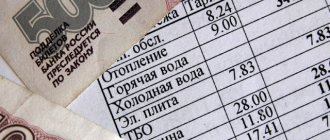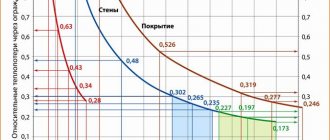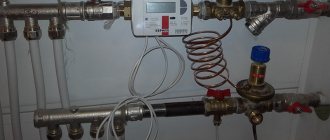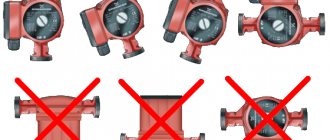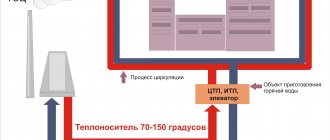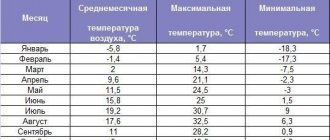The legal topic is very complex, but, in this article, we will try to answer the question "Heating rate per 1 m2 in gcal 2020". Of course, if you still have questions, you can consult a lawyer online for free right on the site.
This article is the seventh publication of the series "Myths of housing and communal services", dedicated to debunking the false theories of the housing sector. Myths and false theories, widespread in the housing and communal services of Russia, contribute to the growth of social tension, the development of the "Concept of enmity" between consumers and service providers, which leads to extremely negative consequences in the housing industry.
In heating systems, the coolant (hot water) enters the heating system at one temperature and exits at another. That is, I came with one amount of warmth and left with another. The coolant gives off some of the heat to the environment through heating radiators.
How to calculate your heating bill
Zone I - within the Third Transport Ring, Zone II - the rest of the city of Moscow. Through a fraction is given: I zone / II zone. Based on the definition, 1 calorie of heat (energy) is needed to heat 1 gram of water by 1 degree Celsius. Therefore, to heat one ton of water (1 million grams) by 1 degree, 1 million calories or 1 megacalorie (Mcal) is required.
Special attention should be paid to the situation in which the charge for heating is carried out according to the general house meter, if individual heat meters are installed in the apartments. This happens according to the following formula:
When determining the norms, possible resource losses are taken into account, which inevitably arise due to the peculiarities of the process of heat supply through pipes, and losses caused by breakdowns of public utilities are not taken into account.
Take a sociological survey!
You also need to understand the role of the heat consumption rate. Heating accrual according to the standard occurs only if no meters are installed to account for the resource - neither general nor individual. Then the dependence will also be direct: the higher the standard, the more expensive the heat.
Notes: 1. The standard for the consumption of utility services for sewerage is equal to the sum of the standard for cold water supply and the standard for hot water supply. 2. Standards for the consumption of utilities for categories 16 and 16 (1) are also applied to apartment buildings that have been transferred from the category of dormitories, in which the design degree of improvement and equipment with water-distributing devices have been preserved.
From July 1, 2020 new standards for the consumption of communal heating services came into force, as well as standards for the consumption of communal services for heating when using outbuildings located on the land plot, established by order of the Ministry of Energy of Housing and Communal Services of the Samara Region dated 20.06.2016 No. 131.
This is interesting: Sanpin with changes for 2020 at catering establishments and shops
1.2. Utilities Consumption Standards
Information on the value of standards for the consumption of utility services for heating for 12 months is provided for reference. The consumption rates of the heating utility service for 12 months are determined using the coefficient of the frequency of payment by consumers for the heating utility service, equal to 7/12.
During the calculation, it should be remembered that any modern devices have a small error. They are generally acceptable.But you need to calculate the error yourself. For example, this can be done using the following formula: R = (V1 - V2) / (V1 + V2) * 100, where:
If you have an individual device installed, you will be able to avoid any problems and overpayments. It is enough for you to take monthly indicators from the meter and multiply the resulting number by the tariff. The amount received must be paid for the use of heating.
Formula for calculating Gcal for heating
Many residents have difficulty converting kilocalories to kilowatts. This is due to many manuals of measuring units in the international system, which is called "C". When converting kilocalories to kilowatts, a coefficient of 850 should be used. That is, 1 kW equals 850 kcal. Such a calculation is much easier than others, since it is not difficult to find out the required amount of gigacalories. 1 gigacalorie = 1 million calories.
Calculation No. 3: The amount of payment for heating in a residential / non-residential premises, an ODPU is installed on an apartment building, there are no individual metering devices in all residential / non-residential premises. Read the procedure and an example of calculation →
Heat consumption rate for heating: how heat charges are calculated
Important! You should be aware that there are several schemes for supplying heat to the house and hot water supply. Therefore, before installing metering devices, you must consult with an independent expert. If the devices are installed incorrectly, then you will not save, but overpay for services.
If in winter time in your apartment the temperature is lower than the indicated values, it means that your house receives less heat than the heating norms prescribe. As a rule, in such situations, worn-out urban heating systems are to blame, when precious energy is wasted into the air. However, the heating rate in the apartment is not being met, and you have the right to complain and demand a recalculation.
How to calculate your heating bill
- the amount of heat energy according to the meter readings;
- the total area of all residential and non-residential premises in the house. Using this parameter, you can calculate the share attributable to each specific apartment from the amount that residents of the apartment complex must pay for heat according to the readings of the general meter.
Interesting: How to get back the tax deduction for the purchase of a house and land
-standards for all utilities, that is, their calculations do not agree with the public regarding the absence of a corruption component, therefore, they overestimate all indicators for entering into the formula for calculating the standard for each service, (the area of premises is understated by 150,000 m2, the outside temperature is overestimated, the duration of the heat supply, the heat load of the premises is overestimated);
Heat tariffs for the population in 2020
It turns out that in reality the prices for heating and hot water supply imply payment not only for the consumed heat and hot water. In addition, the residents of the houses pay for the repair and maintenance work that must be carried out for the pipeline system. This, in turn, requires equipment costs, workers' wages, and so on. That is, the final value of tariffs for heat energy largely depends on the condition of the pipes. You can check this yourself if you know how much 1 Gcal of heat energy costs in the region.
The cost of hot water supply in the Moscow region is now 151 rubles 35 kopecks instead of 135 rubles per 1 cubic meter for homeowners using MOEK metering devices. And those who have installed Mosenergo meters from July 2020 must pay 120 rubles for each cubic meter, instead of 108.
The procedure for calculating payment for heating
The component for cold water is the volume of cold water for the needs of hot water supply.It is determined in the presence of individual metering devices - according to the indications of a hot water metering device, in the absence of an individual metering device - according to the standard - 3.5 m3 / person. per month.
The component for thermal energy for the needs of hot water supply is determined according to the readings of the general house metering device for metering hot water consumption. The amount of heat energy recorded by the general house meter is distributed in proportion to the consumed volume of hot water.
How are the heating bills calculated in an apartment building?
In order to make the calculation correctly, ask the office of the company - the service provider the value of the established tariff and the heat standard per unit area. The above formula allows you to calculate the cost of 1 square meter of heating for an apartment or a private house connected to a centralized network (substitute 1 for S).
- P - the amount to be paid;
- S - total area (indicated in the technical passport of an apartment or a private house), m²;
- N is the rate of heat released for heating 1 square meter of area during a calendar month, Gcal / m²;
- T - tariff - the price of 1 Gcal of thermal energy.
The rate of gcal per square meter in 2020
In accordance with Resolution of May 23, 2006 No. 306 (as amended on April 16, 2013) in the event that it is possible to install a meter, the new standards for the consumption of housing and communal services (HCS) from the beginning of the year will now be increased in accordance with the increase coefficient.
Recommended Reading: Student Goes to University and Receives 2020 Drop-Out Scholarship
In this case, the calculation is carried out taking into account the heating rate. For example, it is equal to 0.25 Gcal per square meter. Multiply it by the area of the heated premises and by the tariff accepted in your area. To this value is added the payment for common house energy according to the standard, divided into all owners in full.
How to calculate your heating bill in 2020
Once a year, owners of apartments with distributors have the right to apply for a recalculation of the heating fee. The communal structures will not be able to refuse this. In fact, the distributor only allows you to correct the previously paid heating payment.
Interesting: How to find out the list of residents of the house at the address
If a heating meter is not installed in an apartment or house, payment for it will be made according to the standard. At the same time, the amount payable for the season can be distributed over the entire year. This allows you to reduce costs, but forces you to pay them all year round, which is not always advisable.
Basic standards for the consumption of thermal energy for heating
The choice of this or that calculation method depends on whether a heat meter is installed in the house and apartment. In the absence of a common house meter, tariffs are calculated in accordance with the standards, and those, as we have already found out, are determined by local authorities. This is done through a special decree, which also determines the payment schedule - whether you will pay all year round or exclusively during the heating season. And if you want to know the exact numbers specifically for your region, you can:
The rate of consumption of thermal energy for heating is directly related to the temperature rates in a particular room. At the beginning of the article, we already mentioned what the temperature should be in each of the rooms. But how the measurements are to be taken is key here. There are certain requirements, let's consider them.
Calculation of Gcal for heating
Note! On average, the consumption standard in Russia per square meter is 0.0342 Gcal per month. Of course, this figure may vary for different regions, since it all depends on climatic conditions.
We continue to talk about the calculation of Gcal for heating. Owners of country houses are primarily interested in the cost of a gigacalorie of thermal energy obtained from a particular type of fuel. The table below can help with this.
Heating rates per 1 square meter
The optimal microclimate in the living space is ensured by correctly selected radiators. The manufacturer encloses a technical data sheet with each product. It indicates the power of a radiator of any kind, based on the size of one section or block. This information is important for calculating the dimensions of the unit, their number, taking into account some other factors.
Resolution No. 306 “Rules for Establishing and Determining Utility Consumption Standards; Table 7 - "The value of the standardized specific consumption of heat energy for heating an apartment building or residential building").
Gigacalories per square meter
As noted above, you cannot install the meter yourself. This can only be done by a licensed specialist, and you should first draw up an installation project and agree on it. And this, frankly, can cost twice as much as the device itself. In addition, there are technical difficulties. In the case of horizontal routing, there is no problem. But often in apartments there is also a vertical wiring, in which each room has a separate riser, from which one or two radiators are powered. In this case, it is impractical to install a meter in front of each battery. Note! It must be remembered that there are several schemes for heat supply or hot water supply at home at once. For this reason, be sure to speak with an independent expert before installing the meter. After all, if you install the device incorrectly, then you will not save, but, on the contrary, will overpay.
What is this unit - gigacalorie? How does it relate to the more familiar kilowatt-hours of thermal energy? What data are needed to calculate the heat received by the room in giga calories? Finally, what formulas are used for the calculation? Let's try to answer these questions. Of course, all measures for calculating heat are much more convenient and easier to perform in private buildings than in apartment buildings with a centralized heating system, where simple equipment cannot be done. Thus, we can say that all calculations to determine the consumption of heat energy in a particular room may well be performed on our own (about
Myths of housing and communal services: Why is the standard of heating consumption measured in Gcal
Let the heating consumption standard be approved in the amount of 0.022 Gcal / sq. Meter, the heat energy tariff is approved in the amount of 2500 rubles / Gcal, the area of the i-th room will be taken equal to 50 square meters. To simplify the calculation, we will accept the conditions that payment for heating is carried out during the heating season, and in the house there is no technical possibility of installing a general-house metering device for heat energy for heating.
This article is the seventh publication of the series "Myths of housing and communal services", dedicated to debunking the false theories of the housing sector. Myths and false theories, widespread in the housing and communal services of Russia, contribute to the growth of social tension, the development of the "Concept of enmity" between consumers and service providers, which leads to extremely negative consequences in the housing industry. The articles of the cycle are recommended, first of all, for consumers of housing and communal services (HCS), however, specialists in housing and communal services may also find something useful in them. In addition, the dissemination of publications from the series "Myths of Housing and Utilities" among consumers of housing and communal services can contribute to a deeper understanding of the housing sector by residents of apartment buildings, which leads to the development of constructive interaction between consumers and providers of utilities. A complete list of articles in the cycle "Myths of housing and communal services" is available at the link>>>
Heating consumption standard MKD
- As a communal heating service, it is linked to heating consumption standards.
- What is "heating consumption standard".
- How to calculate the standard for heating consumption.
- How the electricity consumption standard is related to the heating utilities provided by the MKD.
Interesting: How to get snills for a pensioner in Moscow
In our country, water heating systems are often used today. The heat carrier (usually water) is heated to a predetermined temperature and circulated in the heating system. Gradually, the carrier gives off heat to the room. At the same time, its temperature, respectively, decreases. Heat from the coolant enters the atmosphere, as a rule, thanks to heating radiators.
Heating tariffs in Russia in 2020
According to the forecasts of the Ministry of Economic Development, the growth rate of prices for thermal energy in the period from 2020 to 2020 will be insignificant, the tariff increase will not exceed 4% per year... The tariff change usually takes place from the middle of the year, for example, since the middle of summer in 2020, the payment per unit of energy in Moscow has increased from 2199.24 to 2279.95 rubles, i.e. the increase was only 3.67%. A similar increase should be expected in mid-2020.
Recommended reading: Zemsky Paramedic 2020 Severouralsk
In Tyumen, from the middle of the year, a single provider of heating services for apartment buildings for the population ("UTSK") was selected, and the tariff was 1,610.68 rubles. In Yaroslavl, the increase in prices for utilities also did not exceed 4%, the tariff increased from 1,551 rubles. up to RUB 1615 In the Krasnodar Territory, the tariff increased from 1993.61 rubles / Gcal to 2038.12 rubles / Gcal.
New payment procedure for heating
Recall - Rules 354 amended Rules 307, according to which, from September 1, 2012, the provisions of Rules 307 in relation to all utilities except for heating became invalid. Since Rules 354 provided for payment for utility services for heating on the fact of consumption (that is, exclusively during the heating period - either by metering devices or by consumption standards), and Rules 307 provided for payment for heating during the year in monthly equal payments with a adjustments to the payment, the Government of the Russian Federation gave the constituent entities of the Russian Federation the right to decide on the choice of the method of payment for heating - either according to Rules 354, or according to Rules 307. At the same time, the existence of two options for heating payments was declared as temporary, established for a certain "transition period" necessary to refuse of the norms of Rules 307 and the establishment of the procedure for payment for heating provided for by Rules 354. The date of December 31, 2014 was set as the end date for such a "transition period", after which a single and unique the order of payment for heating, regulated by Regulation 354.
Recommended reading: Homeless Children of Skyrim
On June 30, 2020, the validity period of the RF PP dated May 23, 2006 finally expired N307 (hereinafter referred to as Rules 307) - the same decree providing for payment for heating in equal monthly installments throughout the year. Now the procedure for calculating the payment for heating is determined exclusively by the decree of the Government of the Russian Federation of 05/06/2011 N354 (hereinafter referred to as Rules 354). However, the norms of Rules 307 did not disappear - it was on the last day of the validity of Rules 307 that the RF Resolution of 06/29/2016 entered into force N603, by which the procedure for calculating the payment for heating provided for in Regulation 307 is included in Regulation 354 as one of the options for calculating the payment for heating.
The formula for calculating gcal for heating
It's very simple: gigacalories are used in calculations for heat. Knowing how much heat energy is left in the building, the consumer can be billed quite specifically. For comparison - when central heating is operating without a meter, the bill is billed for the area of the heated room.
Note! The design of the meter implies the presence of electronics. The vast majority of such modern models provide not only dry information (temperature of the working fluid, its flow rate), but also determines the actual use of thermal energy. The control module here is equipped with a port for connecting to a PC and can be manually configured.
Recommended Reading: Grants And Subsidies In 2020
How many gcal is needed for heating 1 sq m standard 2020
the increase was only 3.67%. A similar increase should be expected in mid-2020. It is also worth noting that in the capital and the regions more and more often in new high-rise buildings, modern residential complexes and elite club houses, an autonomous heat supply system is being created with its own boiler houses, designed to heat one or several houses.
- K - coefficient that determines the frequency of payment for the resource. It is calculated by dividing the number of months in the heating season by the number of months in a year. If the heating season lasts six months, then K = 6/12 = 0.5.
- H - standard for heat consumption;
- T is the tariff for the consumed utility service;
- PL is the area of the heated apartment;
- S.o. - the amount of payment according to the receipt;
A gigacalorie is what it is
As it is clear from the definition, the size of 1 calorie is small. For this reason, it is not used for calculating large quantities, especially in power engineering. Instead, a concept such as a gigacalorie is used. This value is equal to 10 9 calories, and it is written in the form of abbreviation "Gcal". It turns out that there are one billion calories in one gigacalorie.
In numbers, it looks like this. According to the regulations, the temperature of the water in the pipes for heating must be at least +55 ° C. And if we take into account that the minimum t of water in power systems is +5 ° C, then it must be heated by 50 degrees. It turns out that 0.05 Gcal is used for each cubic meter. However, to compensate for heat loss, this coefficient is overestimated to 0.059 Gcal.
How to convert gcal to cubic meters
Confusion often arises when calculating monthly payments for heating and hot water. For example, if in an apartment building there is a common heat meter, then the calculation with the heat energy supplier is carried out for the consumed gigacalories (Gcal). At the same time, the hot water tariff for residents is usually set in rubles per cubic meter (m3). To understand payments, it is useful to be able to convert Gcal to cubic meters.
Instructions
It should be noted that heat energy, which is measured in gigacalories, and the volume of water, which is measured in cubic meters, are completely different physical quantities. This is known from the high school physics course. Therefore, in fact, we are not talking about converting gigacalories to cubic meters, but about finding a correspondence between the amount of heat spent on heating water and the volume of hot water obtained.
By definition, a calorie is the amount of heat required to heat one cubic centimeter of water by 1 degree Celsius. A gigacalorie, used to measure heat energy in heat and power engineering and utilities, is a billion calories. In 1 meter there are 100 centimeters, therefore, in one cubic meter - 100 x 100 x 100 = 1,000,000 centimeters. Thus, to heat a cube of water by 1 degree, it will take a million calories or 0.001 Gcal.
The temperature of hot water flowing from the tap must be at least 55 ° C. If the cold water at the entrance to the boiler room has a temperature of 5 ° C, then it will need to be heated by 50 ° C. Heating of 1 cubic meter will require 0.05 Gcal. However, when water moves through the pipes, heat losses inevitably occur, and the amount of energy spent on providing hot water supply will in fact be about 20% more. The average standard of heat energy consumption for obtaining a cube of hot water is taken equal to 0.059 Gcal.
Let's take a look at a simple example. Suppose that in the inter-heating period, when all the heat goes only to provide hot water supply, the heat energy consumption according to the readings of the general house meter was 20 Gcal per month, and the residents, in whose apartments water meters are installed, consumed 30 cubic meters of hot water.
How many square meters per person in 2020
When a citizen found out that the minimum housing rate for 1 person is 6 sq. m., and learned that the value of the indicator in 2020 depends on its type and a number of other parameters, it is necessary to figure out when this information may be needed. Information is required if the calculation of the amount of money that must be provided for housing and communal services is carried out.
According to the current legislation, the number of meters per person can be considered the norm of living space. The authorities of the Russian Federation can independently establish regional norms for the area of housing or transfer this right to local government.
08 Feb 2020 juristsib 5813
Share the entry
- Similar posts
- Benefits for Chernoble Liquidation Participants in 2020
- Dismissal for Drunkenness Article 81 of the Labor Code of the Russian Federation Record in Labor 2020
- On which account of budget accounting to take into account insurance premiums according to the additional standard for harmful working conditions in 2020
- Reporting deadlines in 2020
